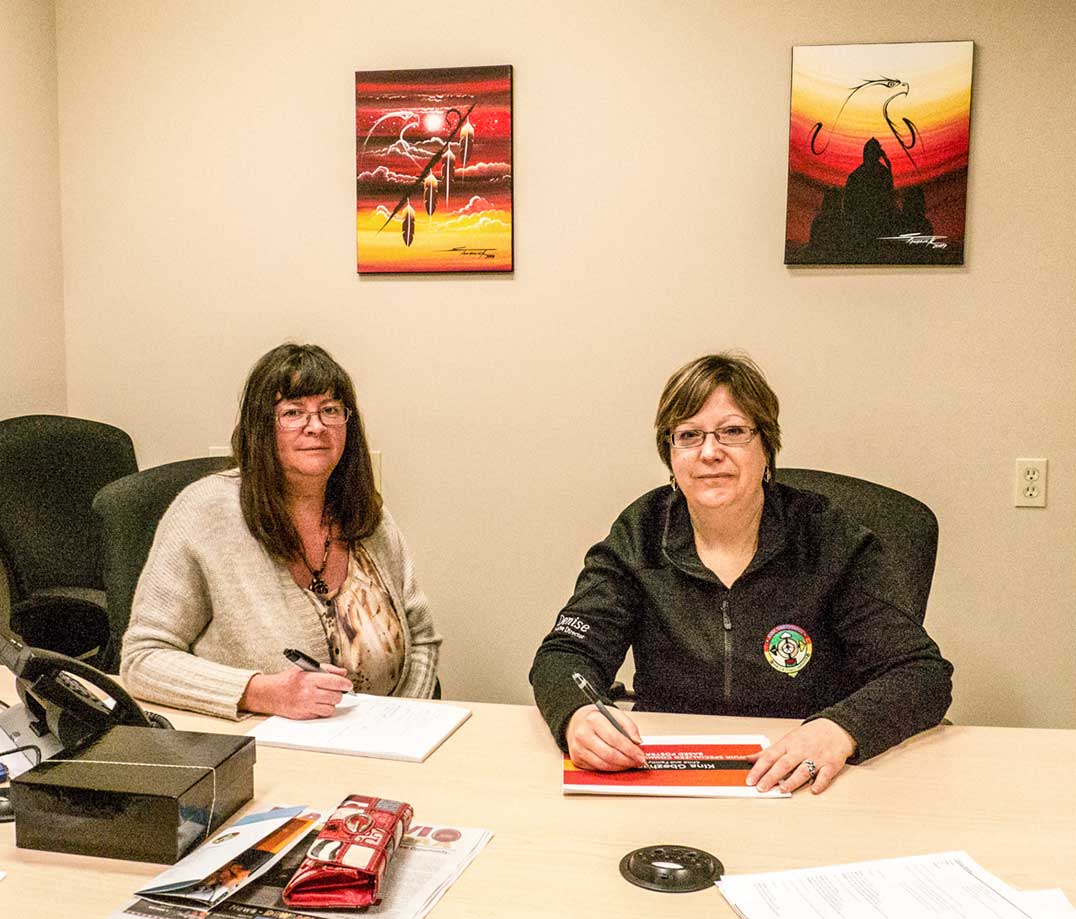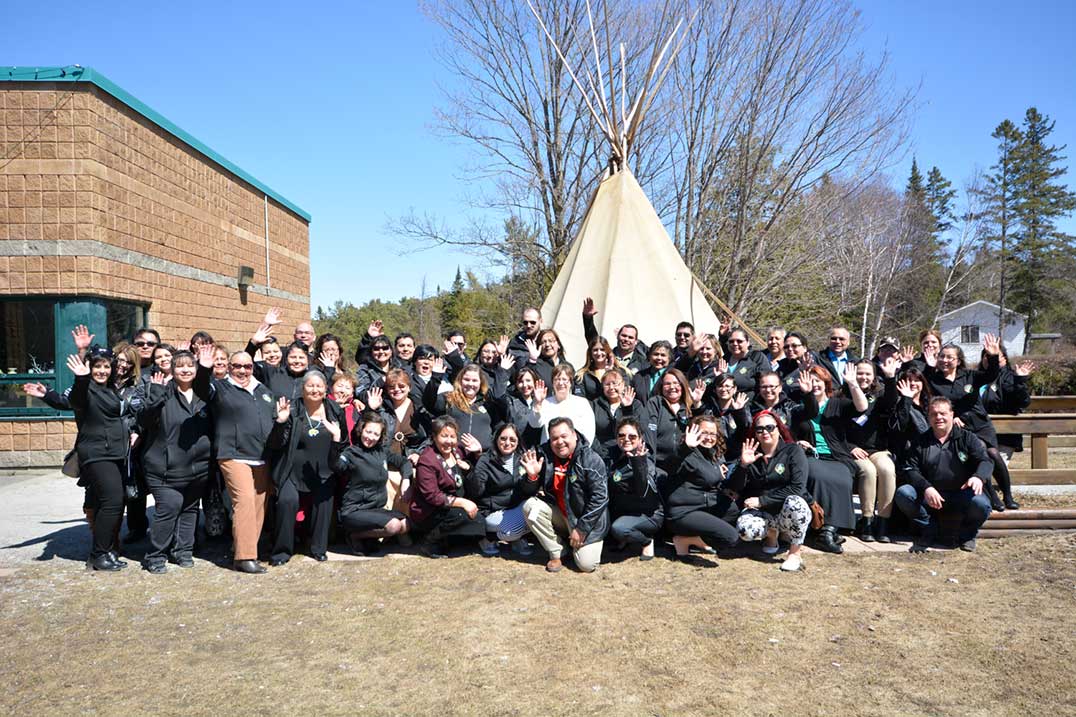by Isobel Harry
MANITOULIN—With the release of the final report of the Truth and Reconciliation Commission (TRC) mid-December, Canada’s child welfare system is in the spotlight, connecting the high number of indigenous youth in jails with “the even more dramatic overrepresentation” of indigenous children in the care of child welfare agencies and laying the blame squarely on the abusive treatment of generations of family members in the residential school system of over one hundred years’ duration.
“For over a century,” says the introduction to the summary of the TRC’s Final Report, “the central goals of Canada’s aboriginal policy were to eliminate aboriginal governments; ignore aboriginal rights; terminate the treaties; and, through a process of assimilation, cause aboriginal peoples to cease to exist as distinct legal, social, cultural, religious, and racial entities in Canada. The establishment and operation of residential schools were a central element of this policy, which can best be described as “cultural genocide.”
Beginning with child welfare, the Commission calls for redress in the legacy of the atrocious barbarities that were visited upon aboriginal children and their families that to this day are marked by the trauma.
However, the report also found that, “Anecdotal evidence and case studies suggest that First Nation agencies are more effective than non-aboriginal agencies in providing service to First Nation clients,” and therefore calls on all governments—federal, provincial, territorial and aboriginal—“to commit to reducing the number of aboriginal children in care by providing adequate resources to enable aboriginal communities and child-welfare organizations to keep aboriginal families together where it is safe to do so, and to keep children in culturally appropriate environments, regardless of where they reside.”
Long before these uncompromising words saw the light of day in the TRC’s final report, Kina Gbezghomi Child and Family Services (KGCFS) began operations in Wikwemikong in 1991, after 20 years of foundational work on child welfare had already been done by Native communities in northern Ontario and by the Chiefs of Ontario. In 1981, the chiefs “endorsed a resolution stating their intent to create their own Indian child welfare laws, policies and programs based on the protection of children within their culture and within their families.”
The TRC’s Calls to Action on child welfare mirror the vision and decades-long strategic planning of Kina Gbezghomi to effectuate radical change in the system to “express affirmation of the inherent aboriginal right of First Nations to care, nurture and sustain the development of their children and youth,” and to institute protection and prevention services that would strengthen and promote healing of families and communities in the process.
In April 2015, after years of intensely focused work by committed staff, board and member First Nations leadership, in partnership with the Children’s Aid Society (CAS) of the Districts of Sudbury and Manitoulin and the Ministry of Children and Youth Services, Kina Gbezhgomi achieved formal designation as a Children’s Aid Society “to provide culturally-based protection services to the children and families in their communities.”

Director Denise Morrow (right) and Manager of Alternative Care Joyce Carrick sat down with the Expositor to discuss the
organization’s groundbreaking work in child welfare.
photo by Isobel Harry
KGCFS Executive Director Denise Morrow told The Expositor, “One area [where] we are unique from a non First Nation CAS is that we are directly accountable to the seven member First Nations (Sheguiandah, M’Chigeeng, Sheshegwaning, Zhiibaahaasing, Aundeck Omni Kaning, Whitefish River First Nations and Wikwemikong Unceded Indian Reserve) through the seven [First Nation] Board of Directors members, appointed through a band council resolution. In this manner, we have dual accountability.”
In addition, Kina Gbezhgomi, “now takes this role [of the CAS], having the mandate for child protection,” says Joyce Carrick, manager of alternative care. “We still complete CAS checks for foster care applicants…We also rely on their historical database for file disclosure to assist us in ensuring a complete and accurate family assessment. We have an ongoing partnership to ensure there are no service gaps around jurisdiction; we also share in some training endeavours, learning opportunities (especially given that we have had to set up many processes the CAS has established), so we are often approaching them to explore their systems. We are accountable to the Ministry [of Children and Youth Services] through file reviews and financial audits as well as program reviews to assess readiness prior to [being mandated] and post-mandate. [Kina’s] accountability oversight by the Ministry is more than other designated CAS’s in the province because of the Ministry’s requirement to ensure readiness and successful implementation.”
Kina Gbezhgomi means “All of us, we are one” in English; the intention of the name can be further elaborated as, “We stand as individuals, each with our own uniqueness, as we all stand together as one,” while another interpretation is, “All of us, we will do this together.”
The “family-centered and family-focused” organisation is committed to delivering services and programs that “empower children, families and communities to participate in all aspects of case planning and decision making,” are “culturally-based, utilizing traditions and practices that strengthen cultural identity for children and families–supporting children to remain in their communities with healthy caregivers to stay connected with their roots, culture and language.“ Elders, now through a newly-created Elders Advisory Committee, help to coordinate teachings in naming, sweat lodge, cedar bath and reunification ceremonies and provide guidance and support to families and staff “in all life’s stages and transitions.” Kina’s mandate is carried out in their three offices in Wikwemikong, M’Chigeeng and Sudbury in the program areas of Foster Care, Customary Care and Prevention.
Foster care enlists Anishinaabe caregivers to provide foster homes in member communities for children who suffer neglect, abuse, exposure to conflict, are orphaned or abandoned or because of the inability of the current caregivers to care for and protect them. Foster parents can be kin of the birth family, or other community members, but all undergo police vulnerable sector and CAS checks; references and a medical report are required as is a housing and safety review. Foster parents receive 24-hour support, home visits, compensation for expenses and care, reimbursement for various activities and education and training supports.
“We are always looking for foster parents within the seven member First Nations; we also recruit foster parents in the jurisdiction of Sudbury and Manitoulin off-reserve who have First Nation status or affiliation,” Ms. Morrow explains. (Non First Nation assistance is welcome in the areas of volunteer drivers, tutors and casual support.)
Customary care is a “traditional practice whereby communities care for and protect the children without the intervention of child welfare authorities [or the courts]…It is a program that recognizes and respects inherent rights of the Anishinaabek.” The need of the child for protection is central to a circle of care that includes the parents and extended family, the First Nation and Kina Gbezhgomi who decide collaboratively on a suitable family to help raise the child. A band council resolution affirms the parameters of the new relationship; participants sign an agreement, are compensated in accordance with the child’s needs and receive other supports.
“Kina Gbezhgomi does not do adoptions,” says Ms. Morrow. “It’s not part of our model, which is about families taking responsibility for their own families.”
“KGCFS uses court as a last resort,” explains Ms. Carrick. “The court system utilized most often in mainstream societies does not work well with our families given the intrusive nature of this intervention and the fact that it creates barriers. Our child welfare service model does not endorse the use of Crown Wardship orders as it takes away the rights of parents and does not allow for them legally to have any decision making powers for their children. It is the most intrusive order that can be made excluding an adoption order.”
“We are most often involved with families without police, although we have a duty to report as do teachers, firefighters and police. Police would be contacted as an emergency first responder and in these situations [involving children], refer to us, or if we are involved first and a criminal offence has occurred we would contact police to make a report. There are many family situations where we are involved that do not fall under these situations.”
The third critical program is prevention—supplying supportive and prevention services to the member First Nations, including advocacy and referral, cultural awareness and life skills, support and counselling, family and parent education, assessment and service planning and involvement related to child welfare court, among other services that are tailored to the needs of each family.
Ms. Carrick adds, “The prevention teams have been devolved to the community models and the seven First Nations have direct oversight and supervision of prevention services…We also provide referrals to the prevention teams when we start working with a family so they can run parallel services to address the [family’s] worries and prevention would typically remain involved to support a family after our closure of a case as well.”
Prevention also involves collaboration with a wide range of other agencies, says Ms. Morrow: “We have working committees with Wikwemikong, and with UCCM, we have established protocols with the police and hospitals and a relationship with Manitoulin Family Resources and their programs for women who suffer violence. We service the same high-risk families and work on service plans for their safety.”
Recently, Indigenous and Northern Affairs Minister Carolyn Bennett announced that the new Liberal government is seeking nothing short of an “overhaul” of the country’s child welfare system. The new federal government has pledged to implement all of the Truth and Reconciliation Commission’s recommendations. This is good news for Kina Gbezhgomi, although it’s been much too long in coming and is tempered by a chronic lack of funding for prevention programs.
The KGCFS executive director explains, “First Nation child and family prevention programs are drastically underfunded. There has been no change to funding in many years and there is no funding formula within Ontario for such programming. Prevention programs provide opportunities to keep families together in a supportive, traditional way and to promote healing. These programs at the First Nation grassroots level should be the first line of defense in helping families resolve the generational trauma that families have endured and continue to suffer from the legacy left by the mass use of the residential school system.” The TRC’s report also acknowledges that, while “indigenous people now have ‘considerable’ control of child-welfare services,” funding is still woefully lacking for many aboriginal agencies.
Kina Gbezhgomi Child and Family Services celebrated its 20th anniversary in 2012, but their own overhaul of the child welfare system started well before then, with the vision of Indigenous leaders who presaged the work of the TRC and who began the arduous journey to respond to needs in their communities that would not wait another hundred years.
For more on Kina Gbezhgomi’s history, ongoing programs and initiatives, visit www.kgcfs.org






